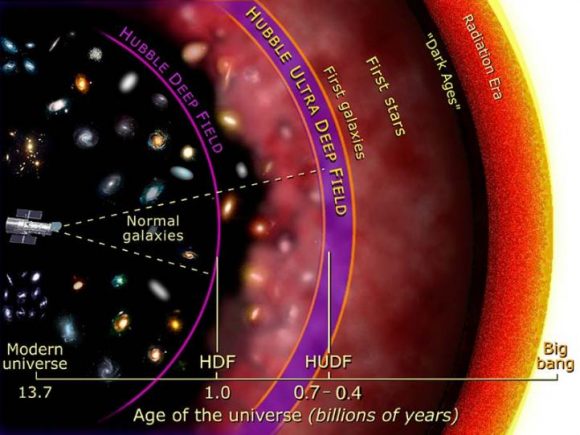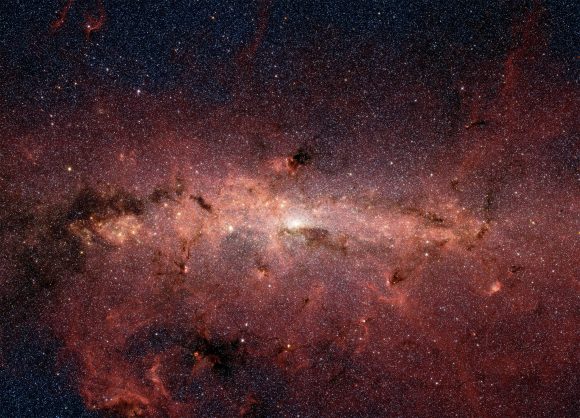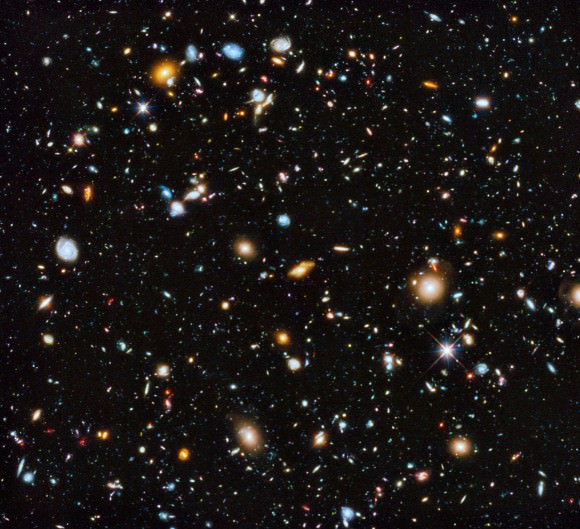In their pursuit of learning how our Universe came to be, scientists have probed very deep into space (and hence, very far back in time). Ultimately, their goal is to determine when the first galaxies in our Universe formed and what effect they had on cosmic evolution. Recent efforts to locate these earliest formations have probed to distances of up to 13 billion light-years from Earth – i.e. about 1 billion years after the Big Bang.
From this, scientist are now able to study how early galaxies affected matter around them – in particular, the reionization of neutral atoms. Unfortunately, most early galaxies are very faint, which makes studying their interiors difficult. But thanks to a recent survey conducted by an international team of astronomers, a more luminous, massive galaxy was spotted that could provide a clear look at how early galaxies led to reionization.
The study which details their findings, titled “ISM Properties of a Massive Dusty Star-forming Galaxy Discovered at z ~ 7“, was recently published in The Astrophysical Journal Letters. Led by researchers from the Max Planck Institute for Radio Astronomy in Bonn, Germany, the team relied on data from the South Pole Telescope (SPT)-SZ survey and ALMA to spot a galaxy that existed 13 billion years ago (just 800 million years after the Big Bang).
Illustration of the depth by which Hubble imaged galaxies in prior Deep Field initiatives, in units of the Age of the Universe. Credit: NASA and A. Feild (STScI)
Just prior to this period, the “Recombination” occurred, where hydrogen and helium atoms began to form. Initially ionized (with no electrons bound to their nuclei) these molecules gradually captured ions as the Universe cooled, becoming neutral. During the period that followed – i.e. between 150 million to 1 billion years after the Big Bang – the large-scale structure of the Universe began to form.
Intrinsic to this was the process of reionization, where the first stars and quasars formed and their radiation reionized the surrounding Universe. It is therefore clear why astronomers want to probe this era of the Universe. By observing the first stars and galaxies, and what effect they had on the cosmos, astronomers will get a clearer picture of how this early period led to the Universe as we know it today.
Luckily for the research team, the massive, star-forming galaxies of this period are known to contain a great deal of dust. While very faint in the optical band, these galaxies emit strong radiation at submillimeter wavelengths, which makes them detectable using today’s advanced telescopes – including the South Pole Telescope (SPT), the Atacama Pathfinder Experiment (APEX), and Atacama Large Millimeter Array (ALMA).
NASA’s Spitzer Space Telescope captured this stunning infrared image of the center of the Milky Way Galaxy, where the black hole Sagitarrius A resides. Image: NASA/JPL-Caltech
“We have used light of about 1 mm wavelength, which can be observed by mm telescopes like SPT, APEX or ALMA. At this wavelength the photons are produced by the thermal radiation of dust. The beauty of using this long wavelength is, that for a large redshift range (look back time), the dimming of galaxies [caused] by increasing distance is compensated by the redshift – so the observed intensity is independent of the redshift. This is because, for higher redshift galaxies, one is looking at intrinsically shorter wavelengths (by (1+z)) where the radiation is stronger for a thermal spectrum like the dust spectrum.”This was followed by data from ALMA, which the team used to determine the distance of the galaxies by looking at the redshifted wavelength of carbon monoxide molecules in their interstellar mediums (ISM). From all the data they collected, they were able to constrain the properties of one of these galaxies – SPT0311-58 – by observing its spectral lines. In so doing, they determined that this galaxy existed just 760 million years after the Big Bang.
“Since the signal strength at 1mm is independent of the redshift (look back time), we do not have an a priori clue if an object is relatively near (in the cosmological sense) or at the epoch of reionization,” they said. “That is why we undertook a large survey to determine the redshifts via the emission of molecular lines using ALMA. SPT0311-58 turns out to be the highest redshift object discovered in this survey and in fact the most distant massive dusty star-forming galaxy so far discovered.”
The Hubble Ultra Deep Field seen in ultraviolet, visible, and infrared light. Image Credit: NASA, ESA, H. Teplitz and M. Rafelski (IPAC/Caltech), A. Koekemoer (STScI), R. Windhorst (Arizona State University), and Z. Levay (STScI)
This rare and distant object is one of the best candidates yet for studying what the early Universe looked like and how it has evolved since. This in turn will allow astronomers and cosmologists to test the theoretical basis for the Big Bang Theory. As Strandet and Weiss told Universe Today about their discovery:
“These objects are important to understanding the evolution of galaxies as a whole since the large amounts of dust already present in this source, only 760 million years after the Big Bang, means that it is an extremely massive object. The mere fact that such massive galaxies already existed when the Universe was still so young puts strong constraints on our understanding of galaxy mass buildup. Furthermore the dust needs to form in a very short time, which gives additional insights on the dust production from the first stellar population.”The ability to look deeper into space, and farther back in time, has led to many surprising discoveries of late. And these have in turn challenged some of our assumptions about what happened in the Universe, and when. And in the end, they are helping scientists to create a more detailed and complete account of cosmic evolution. Someday soon, we might even be able to probe the earliest moments in the Universe, and watch creation in action!
Further Reading: CfA, The Astrophysical Journal Letters
The post The Most Distant Massive Galaxy Observed to Date Provides Insight into the Early Universe appeared first on Universe Today.



No comments:
Post a Comment